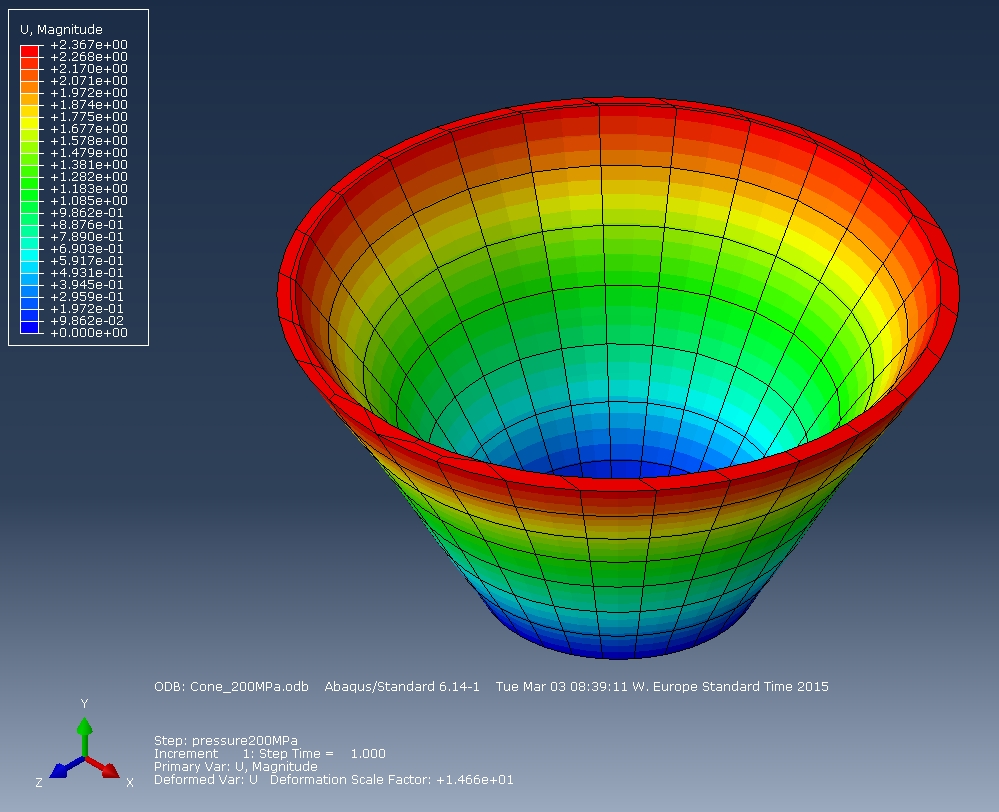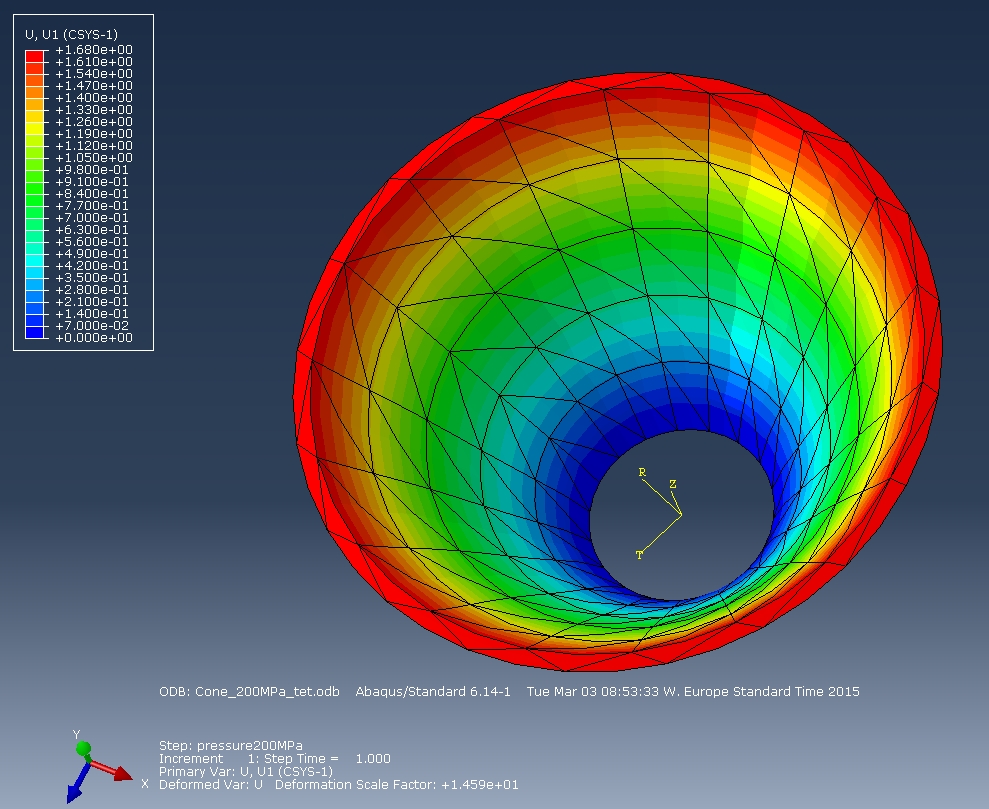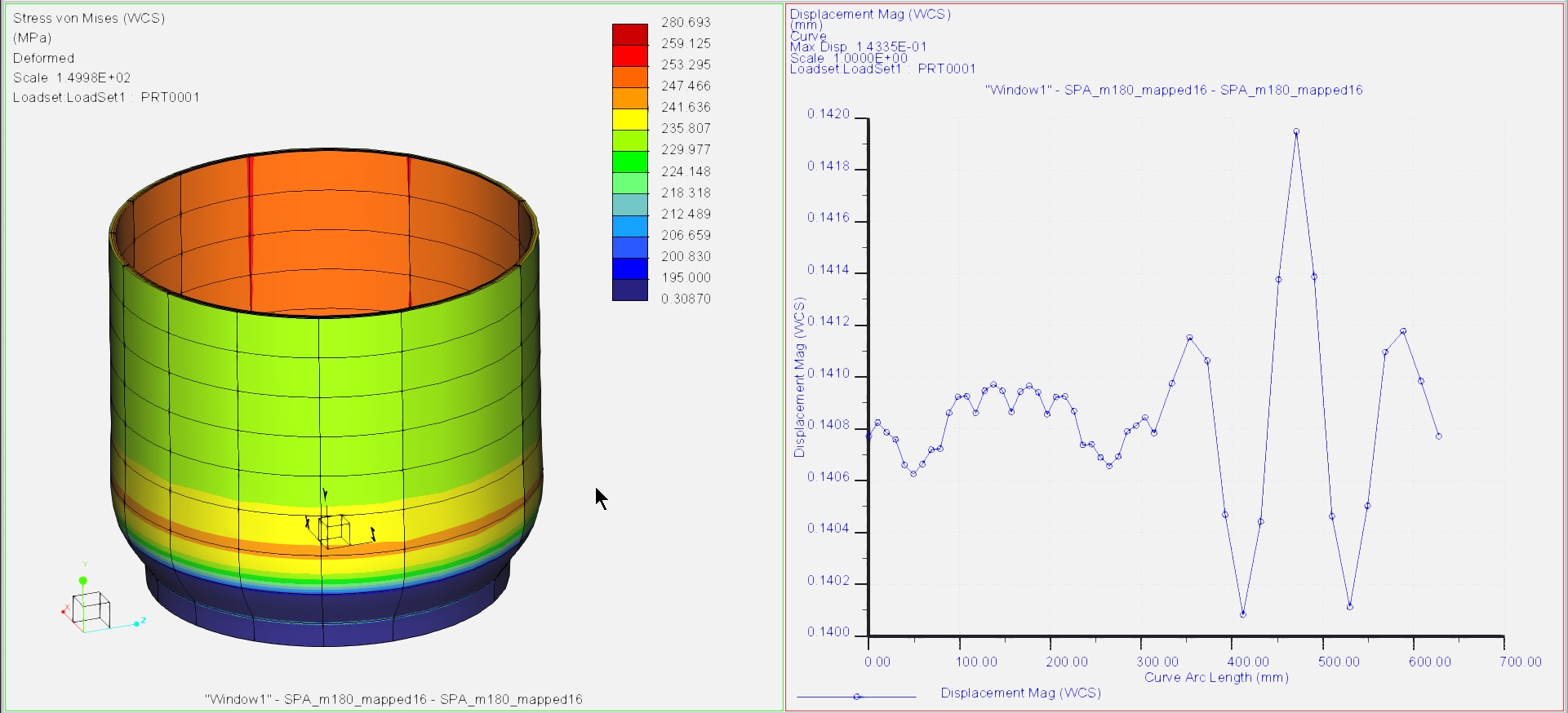Community Tip - Learn all about PTC Community Badges. Engage with PTC and see how many you can earn! X
- Community
- Creo Elements Direct
- Drafting
- Re: Non-symmetric results for symmetric model and ...
- Subscribe to RSS Feed
- Mark Topic as New
- Mark Topic as Read
- Float this Topic for Current User
- Bookmark
- Subscribe
- Mute
- Printer Friendly Page
Non-symmetric results for symmetric model and load?
- Mark as New
- Bookmark
- Subscribe
- Mute
- Subscribe to RSS Feed
- Permalink
- Notify Moderator
Non-symmetric results for symmetric model and load?
Why is it that displacement for a cone is not rotational symmetric for an internal pressure?
A sample model is attached (Creo 3.0) I've brought it back to the bare minimum. 1/4 cone, symmetry, default mesh etc.
It doesn't help if you refine to enormous amounts of elements, Large deformationm analysis makes it slightly better, but it is never right?
Why is that? it should not happen.
How do we solve this?
Extra: I've added a full 360 degree version in Creo2.0 format
- Labels:
-
General
- Mark as New
- Bookmark
- Subscribe
- Mute
- Subscribe to RSS Feed
- Permalink
- Notify Moderator
I'm not able to open your model as I'm on Creo2, but when creating a similar model i find:
* when constraining the symmetry planes with theta=0 the results look strange
* when constraining the symmetry planes with a carthesian csys the results look okay
Not sure if that is the case in your model, but worth a try?
- Mark as New
- Bookmark
- Subscribe
- Mute
- Subscribe to RSS Feed
- Permalink
- Notify Moderator
Hi Patrick
Thanks for your efforts. There is also a Creo 2.0 model in the attachments. That one is 360 degrees, no use of symmetry BC's, severe non-symmetry in the results though. (see the 360 deg picture). we're studying out-of-roundness for a valve, so this result is thoroughly unacceptable (and totally unexpected). Would appreciate your solution
Erik
- Mark as New
- Bookmark
- Subscribe
- Mute
- Subscribe to RSS Feed
- Permalink
- Notify Moderator
Okay disregard my previous message. I was looking at stress, and that looked okay, but displacements were unsymmetric.
The results in your model are unexpected indeed. You should send this to support, they should work with this to improve the software.
A workaround I found is to set the max element size on the pressurised surface to 10mm.
But a simple model like this should not have such bad results using standard settings!
- Mark as New
- Bookmark
- Subscribe
- Mute
- Subscribe to RSS Feed
- Permalink
- Notify Moderator
I get symmetric results. I tried both planar constraints on symmetry surfaces, aswell as constraining "theta"-direction in a cylindrical csys. Default mesh + SPA gives a small deviaiton from perfectly symmetric results, mapped mesh (as in the picture) gives perfectly symmetric results.
/Mats L/
See attached model (Creo2)
- Mark as New
- Bookmark
- Subscribe
- Mute
- Subscribe to RSS Feed
- Permalink
- Notify Moderator
Hi Mats
Very good of you to join!
your model looks like it shows much better results, however: If I plot radial displacements of the top-edge, I get the following
It's only .5% unroundnes. But should be zero.
if I alter the diameter of your cone from 200 to half that, the calculated unroundness increases to 2.8%
I've attached your model again, with added cylindrical coordinate system and in the smaller diameter.
Please dig further. We need to solve this.
A colleague found the same effect in Wildfire 2.0, so it's been in there for quite some time.
- Mark as New
- Bookmark
- Subscribe
- Mute
- Subscribe to RSS Feed
- Permalink
- Notify Moderator
Indeed strange results... File an SPR-report at PTC support... Are there any PTC developers following this forum?
- Mark as New
- Bookmark
- Subscribe
- Mute
- Subscribe to RSS Feed
- Permalink
- Notify Moderator
Correct!
A circular symmetric object under internal (constant) pressure must show circular symmetry in displacements. in short: radial displacement needs to be a flat curve.
I've shown examples where the deviation is close to 10%. Totally unacceptable.
- Mark as New
- Bookmark
- Subscribe
- Mute
- Subscribe to RSS Feed
- Permalink
- Notify Moderator
Hi Steven
All sounds nice, but don't forget, Mat's model is a very finely hex mapped-mesh example.
The default model I used in my original post has a default mesh (typically what you would normally do and what should suffice if you "only" want to know the displacements).
The error in my original post (no tricks, just try the model in "conecreo2p0") the error is a staggering 65%.
It is now PTC support call nr. 12421022.
Let's see what can be done
Erik
- Mark as New
- Bookmark
- Subscribe
- Mute
- Subscribe to RSS Feed
- Permalink
- Notify Moderator
Yes the difference is small, with a symmetrical mesh, but it is still mathematically incorrect. It should decrease when you increase convergence more, but it doesn't. For some businesses, small differences are very important, so we do at least need an explanation for this behavior...
- Mark as New
- Bookmark
- Subscribe
- Mute
- Subscribe to RSS Feed
- Permalink
- Notify Moderator
I've tested with Creo 3.0 M030 today, and the problem still exists in this version...
- Mark as New
- Bookmark
- Subscribe
- Mute
- Subscribe to RSS Feed
- Permalink
- Notify Moderator
Does anyone reading this thread have access to Nastran, Ansys or similar to test an equivalent model in a 'traditional' FE code?
Given that this is a numerical solution I'd expect some imperfections, but it seems easy to get results that are significantly wrong!
- Mark as New
- Bookmark
- Subscribe
- Mute
- Subscribe to RSS Feed
- Permalink
- Notify Moderator
I'll try and run my original version in Abaqus tomorrow.
- Mark as New
- Bookmark
- Subscribe
- Mute
- Subscribe to RSS Feed
- Permalink
- Notify Moderator
In Abaqus it was perfectly symmetrical, already tried it (and threw away the results after checking).
- Mark as New
- Bookmark
- Subscribe
- Mute
- Subscribe to RSS Feed
- Permalink
- Notify Moderator
Tried it in Abaqus too. Made pictures before I threw away the result.
Made very coarse meshes in both hexa's and tets.
Differences in radial displacement around the circumference were less than 1% for both versions.


Erik
- Mark as New
- Bookmark
- Subscribe
- Mute
- Subscribe to RSS Feed
- Permalink
- Notify Moderator
To keep the followers informed: the SPR has been submitted to PTC customer support almost a week ago (wednesday 25 feb). Today they gave the following status report
This is to notify you that I am still investigating your case C12421022. I will keep you informed of my progress.
I find their response disappointingly slow.
Erik
- Mark as New
- Bookmark
- Subscribe
- Mute
- Subscribe to RSS Feed
- Permalink
- Notify Moderator
Dear Steven,
Could you provide you're test model, because I cannot explain why you seem to get good results while we all get bad ones...
- Mark as New
- Bookmark
- Subscribe
- Mute
- Subscribe to RSS Feed
- Permalink
- Notify Moderator
Agnes, here is a file I created for Creo2. Mapped mesh with small deviation in displacement. Still, there is a small deviation where there shouldn't be any. The displacement is smaller where the planar constraints are located. Do the constraints add stiffness somehow?
/Mats L/
- Mark as New
- Bookmark
- Subscribe
- Mute
- Subscribe to RSS Feed
- Permalink
- Notify Moderator
Hi Mats,
I have ran you're model last week increasing the convergence criteria and geometric tolerance in Creo 2 and in Creo 3 m030. It showed the same (small) deviation in symmetry.
Indeed, the constraints seem to be the problem. And in de 360 model it seems to be the way Creo always cuts cylinders in half when selecting. The stiffness in the 360 model is at the location between the half's.
I hope PTC support comes with an explanation/solution. (I am working with Erik Haenen on this case).
- Mark as New
- Bookmark
- Subscribe
- Mute
- Subscribe to RSS Feed
- Permalink
- Notify Moderator
I've checked your model. Indeed, the difference in there is very small; 0.7 % as I see it, using the (flat) mirror constraint and a convergence target of 1%.
When I run your model with 90 degree, and the same small mesh I get a difference of 0.5% on a 1% convergence target, so within the margins. Strange...
When I compare to Mats model, the only difference I see is size of the geometry and the force applied and there I get a difference of 2% both using mirror constraint and using cyclic constraint. In his model I also applied a 1% convergence target which according to the solver was met.
Conclusion; in some models the difference is within limits in others it is too big...
- Mark as New
- Bookmark
- Subscribe
- Mute
- Subscribe to RSS Feed
- Permalink
- Notify Moderator
btw, for the purpose of method documentation; for my percentage difference calculations I've compared the difference to the max displacement instead of the average.
Agnes
- Mark as New
- Bookmark
- Subscribe
- Mute
- Subscribe to RSS Feed
- Permalink
- Notify Moderator
Hi all,
PTC has finally acknowledged this is a fault in the software. It is registered under SPR 2258467 in the knowledgebase.
Hopefully it will be fixed in the next datecode!
Regards,
Agnes
- Mark as New
- Bookmark
- Subscribe
- Mute
- Subscribe to RSS Feed
- Permalink
- Notify Moderator
I see its not in the knowledge base, you can only find it with the 'spr tracker' (if you have access to it, I'm not sure if all customers or only resellers can get there).
Description is; 'Unsymmetrical results for a rotational symmetric cone model and load'
To answer your last question; NO, as many people have demonstrated in this discussion, (very small) mapped mesh and all kinds of symmetry constraints do make the problem smaller (for some but not all geometry), but the root of the problem cannot be solved with those variables.
- Mark as New
- Bookmark
- Subscribe
- Mute
- Subscribe to RSS Feed
- Permalink
- Notify Moderator
Well done Agnes
Anxious to find out what PTC will report on SPR 2258467. It should not have been possible. Everybody runs the majority of analyses with a default mesh and SPA. This should give decent results, especially in displacements. It is the basis of Creo Simulate that you should not worry about meshing. There is no such thing as a margin of safety in this case. we are investigating out-of-roundness for valves, PTC's answer can not be trusted now. (that's a period I just typed)
We'll wait (hopefully only very short)
Erik
- Mark as New
- Bookmark
- Subscribe
- Mute
- Subscribe to RSS Feed
- Permalink
- Notify Moderator
Hi All,
PTC has promised a solution to this problem in Creo 2.0 M170, which should be available on Juli 14th.
Also the SPR number has been updated (they have changed their system). You can now also find it with the new number: 2873817
| SPR | 2873817 / 2258467 | |
|---|---|---|
| Status | Open | |
| Severity | High | |
| Created Date | 11-MAR-2015 | |
| Description | Unsymmetrical results for a rotational symmetric cone model and load | |
| Affected Platform | All | |
| Reported Product | Creo Simulate | |
|---|---|---|
| Module | Creo Simulate | |
| Reported Release | Creo 2.0 | |
| Reported Datecode | M130 | |
| Resolution Status | ||
| Release | Status | Datecode |
| Creo 2.0 | Planned | M170 |
| Creo 3.0 | Evaluating | - |
| Creo 4.0 | Evaluating | - |
- Mark as New
- Bookmark
- Subscribe
- Mute
- Subscribe to RSS Feed
- Permalink
- Notify Moderator
I checked again the SPR today. No new information yet.
- Mark as New
- Bookmark
- Subscribe
- Mute
- Subscribe to RSS Feed
- Permalink
- Notify Moderator
I just ran into this same problem using Creo 3.0 M070. I looked up the SPR and looks like it hasn't been updated. Disappointing.
- Mark as New
- Bookmark
- Subscribe
- Mute
- Subscribe to RSS Feed
- Permalink
- Notify Moderator
Creo3 m080 is available, anyone tested it yet on this problem?
- Mark as New
- Bookmark
- Subscribe
- Mute
- Subscribe to RSS Feed
- Permalink
- Notify Moderator
Agnes: Be my guest
And: Has anyone tried whether it was fixed in creo 2.0 M170?
Should be no problem because on december 28, 2015 Mark Fischer said in Enforced displacement, tangential direction, more than 1 revolution
That he would look into this.
He wrote:
Thank you for your post and I appreciate your feedback. Comments like this are not taken lightly and I am looking into both issues referenced in the above thread (SPR 2848377 and SPR 2873817).
Surely by now Mark knows the status?
Erik
- Mark as New
- Bookmark
- Subscribe
- Mute
- Subscribe to RSS Feed
- Permalink
- Notify Moderator
Hi Eric,
I tested Creo 2 m180 and am very happy with the results; The strange effect halfway the cylinder is gone!
Yes, there is still deviation but it is smaller then the convergence criteria (2% in my case), even with default mesh settings.

With mapped mesh, you can do the same with much less elements, but you do see some deviation over each element. However, this deviation is also smaller then the convergence set. Following example has one half divided into 4 and the other divided into 8 elements. It seems you can control the result much better now with increasing element numbers;

BUT, we saw before that one example can look fine, while another shape shows much bigger deviation, so it would be great if somebody else could confirm this.





